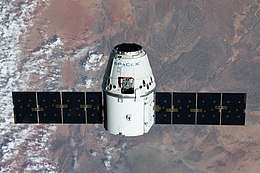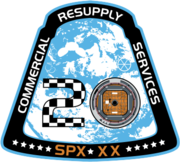SpaceX CRS-20
SpaceX CRS-20 (CRS-20), also known as SpaceX-20, was a Commercial Resupply Service mission to the International Space Station (ISS) launched on 7 March 2020.[1] The mission was contracted by NASA and was flown by SpaceX using Dragon. This was SpaceX's last flight for Dragon CRS (Dragon 1) and concludes the NASA CRS-1 contract extension. The second contract (CRS-2) was awarded in January 2016 and will begin with the SpaceX CRS-21 mission planned for November 2020 using Dragon 2.[3]
 C112 approaches the ISS | |
| Mission type | ISS resupply |
|---|---|
| Operator | SpaceX |
| COSPAR ID | 2020-016A |
| SATCAT no. | 45341 |
| Mission duration | 31 days |
| Spacecraft properties | |
| Spacecraft | Dragon C112.3 |
| Spacecraft type | Dragon CRS |
| Manufacturer | SpaceX |
| Dry mass | 4200 kg |
| Dimensions | Height: 6.1 metre Diameter: 3.7 metre |
| Start of mission | |
| Launch date | 7 March 2020, 04:50:31 UTC [1] |
| Rocket | Falcon 9 |
| Launch site | Cape Canaveral, SLC-40 |
| Contractor | SpaceX |
| End of mission | |
| Disposal | Recovered |
| Landing date | 7 April 2020, 18:50 UTC [2] |
| Landing site | Pacific Ocean |
| Orbital parameters | |
| Reference system | Geocentric orbit |
| Regime | Low Earth orbit |
| Inclination | 51.66° |
| Berthing with ISS | |
| Berthing port | Harmony |
| RMS capture | 9 March 2020, 10:25 UTC |
| Berthing date | 9 March 2020, 12:18 UTC [1] |
| Unberthing date | 7 April 2020, 10:30 UTC [2][1] |
| RMS release | 7 April 2020, 13:06 UTC [2] |
| Time berthed | 29 days |
| Cargo | |
| Mass | 1977 kg |
| Pressurised | 1509 kg |
| Unpressurised | 468 kg |
| Fuel | 705 kg |
| Gaseous | 50 kg |
| Water | 420 kg |
 SpaceX CRS-20 mission patch | |
The Dragon capsule C112 used for CRS-20 previously flew to the ISS on CRS-10 and CRS-16.[4] It arrived at the ISS on 9 March 2020 at 10:25 UTC and was captured by the station's Canadarm2 robotic arm, the last-ever capture of a Dragon with Canadarm2. Cargo Dragon 2 vehicles, which will replace Dragon 1, will dock directly at the space station.[5]
The 1st stage booster B1059 previously supported the CRS-19 mission.
Launch schedule history
On February 2016, it was announced that NASA had awarded a contract extension to SpaceX for five CRS additional missions (CRS-16 to CRS-20).[6] On June 2016, NASA Inspector General report had this mission manifested for 2019,[7] but by June 2019 the launch had been pushed back to March 2020.[8]
Primary payload
NASA contracted for the CRS-20 mission from SpaceX and therefore determines the primary payload, date of launch, and orbital parameters for the Dragon CRS.[9] The CRS-20 mission carries 1977 kg of cargo to ISS.[10]
- Science investigations: 960 kg
- Vehicle hardware: 219 kg
- Crew supplies: 273 kg
- Spacewalk equipment: 56 kg
- Computer resources: 1 kg
- Unpressurized payloads: Bartolomeo Platform 468 kg
Bartolomeo (named for the younger brother of explorer Christopher Columbus), is an external payload platform developed by Airbus Defence and Space, German-built and operated by the European Space Agency. Bartolomeo provides power and data transmission for up to 12 payload slots and is the first external commercial research platform to be installed on the ISS.[11][12]
Along with Bartolomeo, the Dragon cargo mission delivers about a ton of scientific experiments, including biological research investigations studying microgravity's impact on stem cells, intestinal diseases and chemical reactions.[13] The Bartolomeo platform was robotically removed from Dragon's trunk section and installed outside ISS on 2 April 2020. A spacewalk to route power and communication wiring to the Bartolomeo facility for activation has been postponed. The EVA was originally planned in mid-April 2020, but the space station will not be at full staffing level of six crew members until autumn 2020. When activated, Columbus will have a new outdoor deck to host a range of materials science, Earth observation and space science instruments.[14]
Interoperable Radio System (IORS) is the foundation element of the ARISS next-generation radio system on ISS. A total of 4 flight units and 10 total units are being built by the ARISS hardware team. This first IORS radio will be installed in the ISS Columbus module. As of 14 July 2020, the IORS is stowed. The install and operations procedures are now available on board ISS.[15]. The IORS installation, wiring, and activation has been delayed until restoration of six-member crew (Expedition 63) occurs later in 2020. A second flight unit is expected to be launched on a later 2020 cargo flight for installation in the Russian Service module.[16]
The Dragon spacecraft was also packed with spare parts and replacement hardware for the space station's research facilities and life support systems. The components included upgraded hardware for the station's urine processing system, which converts human waste into drinking water. The new components allow NASA teams to test out modifications designed to extend the lifetime of the urine processing system's distillation assembly ahead of future missions to the Moon and Mars, which will require longer-lasting life support equipment.[17][13]
The twenty (20) missions by SpaceX under the CRS-1 contract carried more than 94,000 pounds (43,000 kg) of cargo to the International Space Station, and returned about 74,000 pounds (33,000 kg) of equipment and specimens to Earth, according to NASA.[18]
See also
- Columbus – External Payload Facility
- Amateur Radio on the International Space Station
- SpaceX CRS-21
- List of Falcon 9 launches
References
- Joachim Wilhelm Josef Becker (9 March 2020). "ISS Expedition 62". SpaceFacts.
- https://planet4589.org/space/jsr/jsr.html - 10 May 2020
- Clarke, Stephen (2 March 2020). "SpaceX test-fires rocket, preps for final flight of first-generation Dragon capsule". Spaceflight Now.
- "Dragon C2, CRS-1,... CRS-20 (SpX 1,... 20)". space.skyrocket.de. Retrieved 3 March 2020.
- Wall, Mike (9 March 2020). "SpaceX Dragon cargo ship, the last to be caught by robot arm, arrives at space station". Space. Retrieved 10 March 2020.
- de Selding, Peter B. (24 February 2016). "SpaceX wins 5 new space station cargo missions in NASA contract estimated at US$700 million". Space News.
- NASA Office of Inspector General (28 June 2016). NASA's Response to SpaceX's June 2015 Launch Failure: Impacts on Commercial Resupply of the International Space Station (PDF) (Report). NASA Office of Inspector General. p. 13. Retrieved 18 July 2016.

- "Launch Schedule". Spaceflight Now. Retrieved 12 March 2020.
- Gaskill, Melissa (19 February 2020). "Improving Shoes, Showers, 3D Printing: Research Launching to the Space Station". NASA.

- SpaceX SpX-20 Mission Overview (PDF) (Report). NASA. 6 March 2020. Retrieved 11 March 2020.

- "Bartolomeo (CEPHFISS)". Gunter's Space Page. Retrieved 15 February 2020.
- Staff Writers (27 January 2020). "Bartolomeo starts its journey to the International Space Station". Space Daily.
- Clarke, Stephen (6 March 2020). "ISS to receive new outdoor deck for science experiments". Spaceflight Now. Retrieved 11 March 2020.
- "Pandemic prompts few changes to busy month on space station". spaceflightnow.com - 3 April 2020.
- Bauer, Frank (14 July 2020). "Current status of ISS Stations". ARRIS-USA. Retrieved 28 July 2020.
- "First Element of ARISS Next Generation Radio System Readied for Launch on SpaceX-20". ARISS. Retrieved 17 February 2020.
- "SpaceX CRS-20 NSSDCA/COSPAR ID:2020-016A". NASA. Retrieved 28 July 2020.

- Clark Stephen (7 April 2020). "With successful splashdown, SpaceX retires first version of Dragon spacecraft". Spaceflight Now. Retrieved 28 July 2020.

.jpg)

